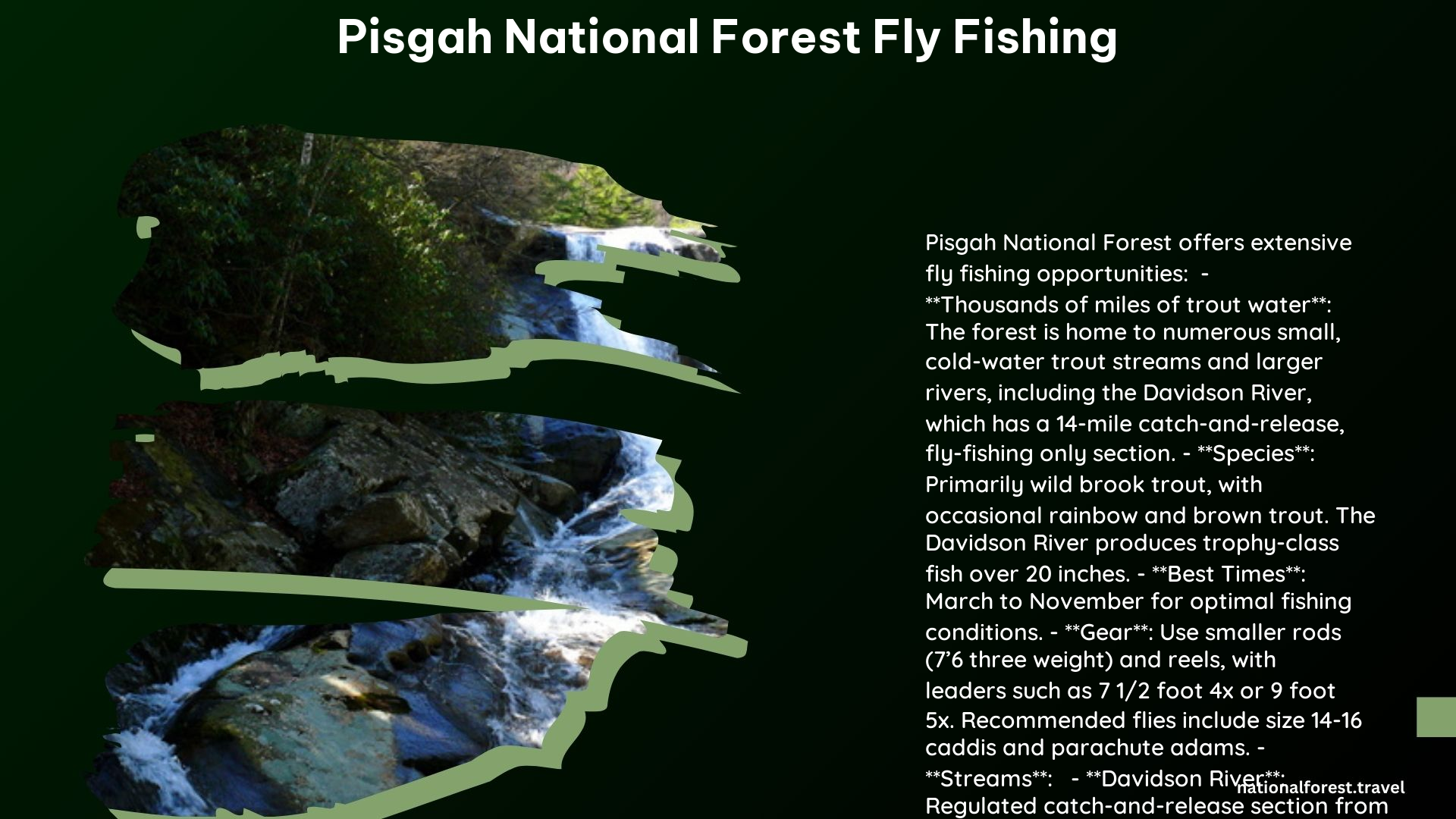Pisgah National Forest offers exceptional fly fishing opportunities with diverse streams and rivers teeming with wild trout. From the renowned Davidson River to hidden gems like Panthertown Creek, anglers can experience a range of fishing environments. The forest’s varied terrain and pristine waters support healthy populations of brook, rainbow, and brown trout, making it a premier destination for fly fishing enthusiasts seeking both challenge and natural beauty.
What Are the Best Fly Fishing Trails in Pisgah National Forest?

Pisgah National Forest boasts several excellent trails that provide access to prime fly fishing spots. Here are some of the top trails:
- Avery Creek Trail
- Length: 3.2 miles
- Difficulty: Moderate
- Access: Pisgah Horse Stables road
- Target species: Wild rainbow and brown trout
-
Best season: Spring and summer
-
South Mills River Trail
- Length: Varies
- Difficulty: Easy to moderate
- Access: Cradle of Forestry Historic Area off Highway 276
- Target species: Wild brown and rainbow trout
-
Best season: Year-round, except summer
-
Panthertown Creek Trail
- Length: Significant hike required
- Difficulty: Moderate to challenging
- Access: Panthertown Valley
- Target species: Wild Brook Trout
- Regulations: Catch-and-release, single hook, artificial lures only
Where Are the Top Backcountry Streams for Fly Fishing?

Pisgah National Forest offers several backcountry streams that provide excellent fly fishing opportunities:
- Davidson River
- Location: Along Highway 276
- Trout size: 7-9 inches, with trophy fish over 20 inches in upper sections
- Best seasons: Spring and fall
-
Regulations: Upper 14 miles are catch-and-release, fly-fishing only
-
North Mills River
- Trout size: 6-10 inches (stocked)
- Stocking: 11,000 trout between October and June
-
Tip: Fish on weekdays to avoid crowds
-
South Mills River
- Target species: Small, wild brown trout
-
Best fishing: Below the old gauging station on FS 476
-
West Fork of the Pigeon River
- Location: Follows Hwy. 215
- Regulations: Upper portion is Wild Trout water, lower is Delayed Harvest
- Technique: Best fished using dry-and-dropper rigs
What Fly Fishing Species Are Available in Pisgah National Forest?
Pisgah National Forest supports three main trout species:
- Brook Trout
- Habitat: Remote, less accessible streams
- Peak seasons: Spring and fall
-
Regulations: Often in Wild Trout waters with strict catch-and-release rules
-
Rainbow Trout
- Abundance: Common in Davidson River and North Mills River
- Peak seasons: Spring and fall
-
Regulations: Vary by location, including catch-and-release and Delayed Harvest
-
Brown Trout
- Habitat: Davidson River and South Mills River
- Peak seasons: Spring and fall
- Regulations: Similar to rainbow trout, with specific protections in place
What Are the Fishing Regulations in Pisgah National Forest?
Understanding and adhering to fishing regulations is crucial for responsible angling in Pisgah National Forest:
| Regulation Type | Details |
|---|---|
| Permitted Methods | – Fly fishing only in certain sections (e.g., upper Davidson River) – Single hook, artificial lures only in Wild Trout waters |
| Licensing | Valid North Carolina fishing license and trout stamp required |
| Catch Limits | Vary by stream and season; many areas are catch-and-release |
| Seasonal Restrictions | – Delayed Harvest streams: Catch-and-release from October through May – Some streams have closed seasons or specific fishing times |
How to Choose the Right Flies for Pisgah National Forest?
Selecting the appropriate flies is crucial for success in Pisgah National Forest:
- Dry Flies
- Elk Hair Caddis (sizes 12-16)
- Parachute Adams (sizes 12-18)
-
Blue Wing Olive (sizes 16-20)
-
Nymphs
- Pheasant Tail (sizes 14-18)
- Hare’s Ear (sizes 12-16)
-
Prince Nymph (sizes 12-16)
-
Streamers
- Woolly Bugger (sizes 6-10)
- Sculpzilla (sizes 4-8)
- Muddler Minnow (sizes 6-10)
Match your fly selection to the season, water conditions, and observed insect activity for best results.
What Equipment Is Essential for Fly Fishing in Pisgah National Forest?
To make the most of your fly fishing experience in Pisgah National Forest, ensure you have the following equipment:
- Rod and Reel
- 3-5 weight rod for small streams
-
5-6 weight rod for larger rivers
-
Waders and Boots
- Breathable waders for comfort
-
Felt or rubber-soled wading boots for traction
-
Accessories
- Landing net
- Forceps for hook removal
- Nippers for cutting line
-
Fly box with assorted flies
-
Safety Gear
- First aid kit
- Sun protection (hat, sunscreen, sunglasses)
-
Insect repellent
-
Navigation
- Map of the area
- GPS device or smartphone with offline maps
How to Plan a Successful Fly Fishing Trip to Pisgah National Forest?
To ensure a successful fly fishing trip to Pisgah National Forest, consider the following tips:
- Research and Preparation
- Study stream reports and fishing regulations
- Check weather forecasts and water conditions
-
Obtain necessary licenses and permits
-
Timing
- Plan your visit during peak seasons (spring and fall)
-
Consider weekday trips to avoid crowds
-
Location Selection
- Choose streams based on your skill level and preferences
-
Explore both popular and lesser-known fishing spots
-
Technique
- Practice casting before your trip
-
Learn to read water and identify likely fish holding areas
-
Conservation
- Practice catch-and-release when possible
- Use barbless hooks to minimize fish injury
- Pack out all trash and leave no trace
By following these guidelines and respecting the natural environment, you can enjoy a rewarding fly fishing experience in the beautiful Pisgah National Forest.
References:
1. Fishing in Pisgah National Forest – Meraki Escape
2. Fishing Pisgah National Forest
3. Wild Trout in the Pisgah National Forest – The Catawba Angler
